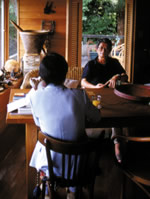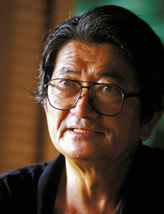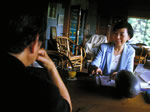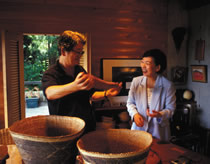| Biohistory journal,Winter, 2004: Index > The difference among "living creatures","Homo Sapience" and "humans" |
| Dialogue/Narration Cultural anthropology The difference among “living creatures”, “Homo Sapience” and “humans” Junzo Kawadao and Keiko Nakamura |
| I perused the records of his books and interviews. While I definitely wanted to hold a conversation with him, I was honestly hesitant to do so because he seemed a little frightening. As I expected, he was a person exacting with language. Though I said that I want to think about the meaning of language for human beings and for biohistory, I reflected that I was a bit lax, and I will think carefully about the important things pointed out here. Our discussion was very rewarding for me. (Keiko Nakamura) |
 |
| Photograph: Naruaki Onishi | |
|
After the dialogue / Junzo Kawada | ||
| I would like to express my sincere respect for Keiko Nakamura for her insight in noticing the importance of narration for biohistory, because mathematical formulas and diagrams of chromosomes alone are incapable of completely expressing living creatures. The conversation was very pleasant on our first meeting, despite talking about the daunting and difficult circumstances. I had the impression of a great potential for verbal communication, a subject we discussed in this dialogue. I think that's because we shared a lot of common ground in our ideas before we began to talk. Perhaps we found each other as kindred spirits. After our conversation, however, it will not be an easy matter for both of us to determine how to apply the content of our dialogue in our respective fields. |
| An epic poem is a history and it coheres the past to the present by narration. |  |
 |
Genomes in our body are the clue to decoding both the history and present day at the same time. To narrate the living creatures with the past as present, it’s Biohistory. |
| From the editors |
| We visited Prof. Junzo Kawada on a hill overlooking a mandarin orange grove. Invited by swallowtail butterflies, we proceeded through a stand of trees. This was our first meeting, so we had some butterflies of our own as we pressed the doorbell. Prof. Kawada, dressed in a black shirt with a matching black cat at his feet, invited us inside. "This is Rafi," he explained. "Its name means "full of life" in the Mossi language." His first Rafi was his pet in Africa, and this is the second. On the wall were African masks and drums made from natural materials. They seemed as if they were about to tell a story. The subject of narration already had begun. Prof. Kawada told us that during his first two years in the college he concentrated on biology. The director asked that with all the different languages in the world, was it was possible to translate one language into another. In reply, he pointedly asked whether true communication was possible through language. There is narration dependent on voice and gestures. Beginning with the death throes communicated that transcend species, there are levels in the ties between voice and meaning. Prof. Kawada was entranced by the sounds among these that transcended culture to communicate, though there was no conceptual thought. His starting point is homo sapiens as an organism with culture. Prof. Kawada told that the observation of Mossi society from the cultural perspective of West Africa, France, and Japan, which has no historical ties to the region, might discover the principles of human beings by a logical comparison within this lack of ties. Prof. Kawada pointed out that history is a chronicle and documents are an epic, to which Ms. Nakamura replied that living creatures are a document because they narrate as an epic. An epic distills the past in the present. The genome functions both as an old document and as an epic in the present. Biohistory continues to narrate from the three viewpoints of living creatures and homo sapiens linked by the genome, and homo sapiens and human beings differentiated by language. |
 Junzo Kawada Junzo KawadaBorn in Tokyo in 1934, Dr. Kawada specializes in cultural anthropology. He received his doctorate in ethnology from the Rene Descartes University Paris V (Sorbonne) after graduating from the School of Arts and Science in the University of Tokyo. After serving as a professor at the Research Institute for Languages and Cultures of Asia and Africa at the Tokyo University of Foreign Studies, he now is a professor at Kanagawa University. He has authored many books, among them Koya kara—Afurika de Kangaeru (From the Plain—Some Thoughts in Africa) (Chikuma Shobo), Mumoji Shakai no Rekishi (The History of a Community with No Written Language) (Iwanami Shoten), Koe (Voice) (Chikuma Shobo), and Koto Densho Ron (A Theory of Oral Dissemination) (Kawade Shobo Shinsha). |
| Dialogue |
|
Please close a window with the button of a browser who are turning off Javascript. |
